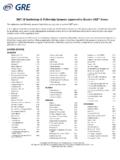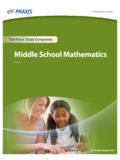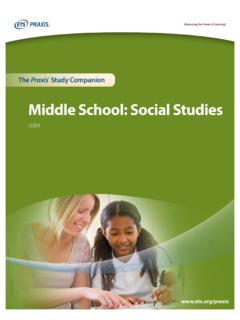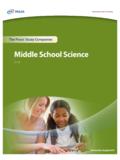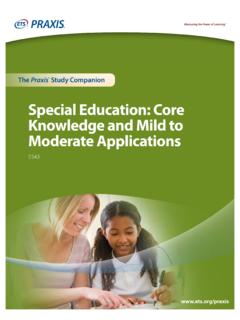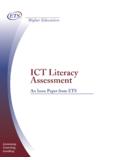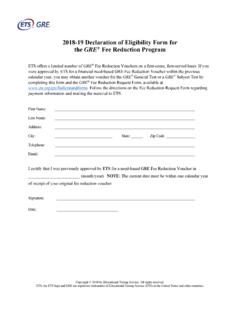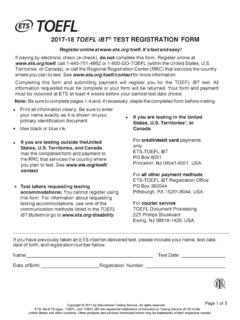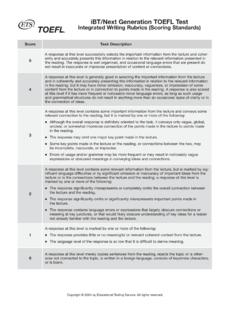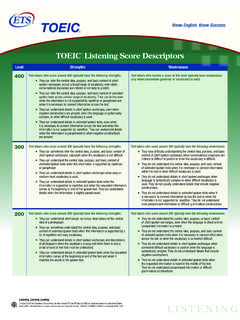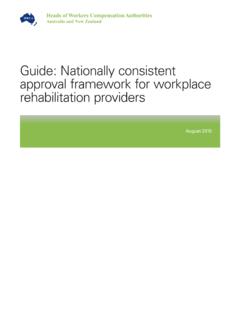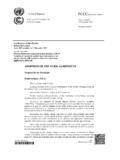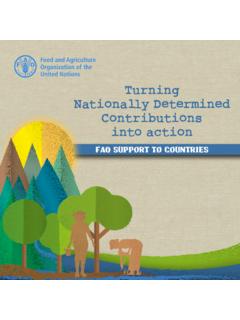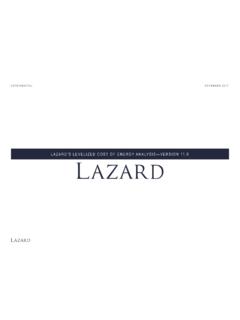Transcription of Poverty and Education: Finding the Way Forward - ETS Home
1 Poverty and Education: Finding the Way Forward TA B L E O F CO N T E N T S. PREFACE.. 2 This report was written by: Richard J. Coley .. 2. educational testing Service EXECUTIVE SUMMARY AND .. 3. Bruce Baker INTRODUCTION.. 7 Rutgers University PARSING THE Poverty .. 12 Author contacts: The Poverty Rate.. 12. The Research Supplemental Poverty Measure.. 13. The views expressed in this report Comparing the Two .. 14 are those of the authors and do not How the United States Compares Internationally.. 15 necessarily reflect the views of the officers and trustees of educational The Income-to- Poverty Ratio.
2 15. testing Service. Copies can be Extreme .. 16 downloaded from: Considering Income and .. 17. What Does All This Mean for a Hypothetical Family of Four? .. 17 Copyright 2013 by educational testing Service. CHILDHOOD Poverty AND ITS .. 19. All rights reserved. ETS, the ETS logo, Families and Parenting Behavior.. 19 LISTENING. LEARNING. LEADING., GRE, TOEFL and TOEIC are registered Exposure to Toxins.. 19. trademarks of educational testing Food Insecurity.. 20 Service (ETS). THE PRAXIS SERIES is a trademark of ETS.
3 All other trademarks Parent Employment.. 21. are property of their respective owners. Health Insurance.. 21. July 2013. Child .. 23. ETS Center for Research on SEGREGATION AND ISOLATION IN AMERICA'S SCHOOLS.. 25 Human Capital and Education Research and Development THE ROLE OF .. 30. educational testing Service Federal Poverty Programs.. 31 Rosedale Road Federal Education Programs and Policies.. 32 Princeton, NJ 08541-0001. State-Funded Education Programs and Policies.. 35. THE PATH .. 40. CONCLUSIONS.. 45. REFERENCES.
4 47. APPENDIX A.. 56. APPENDIX .. 56. APPENDIX C.. 57. APPENDIX D.. 57. P R E FAC E. As citizens, we should concern ourselves with the question of whether the current levels of Poverty and inequality really matter. The answer is they matter a great deal. As noted in this report , Poverty is a significant and growing problem for America one that costs our economy hundreds of billions of dollars each year, and leaves poor families and individuals with a greatly reduced chance of achieving the American Dream. Children raised in Poverty today will grow up in circumstances that, the data tell us, will give them a small, if not negligible, chance of following a path that will lead them to a markedly better place than where they began.
5 This report makes an important contribution to those who are interested in developing a broader and deeper understanding of the connections among Poverty , education and outcomes. Information is provided that deals with issues such as home factors, food security, availability of health insurance and child care, and comparisons are made between poor and non-poor children. On the resource side, the authors provide analyses of programs and funding mechanisms intended to disrupt the effects of Poverty on educational outcomes.
6 The report also provides evidence of the increased levels of social and residential stratification in our schools and society, and considers not only how Poverty is officially measured but several alternative measures that help to broaden our perspective. In providing this information, this report gives us a more nuanced picture of Poverty in America and the consequences it is having on our country. But the report does more than just provide a picture of Poverty and how it is measured: it also presents strategies that may make a difference and are within the purview of education policymakers.
7 Irwin Kirsch Director, Center for Global Assessment, ETS. AC K N O W L E D G M E N T S. The authors wish to acknowledge the contributions of many individuals who played significant roles in the preparation of this report . First the authors wish to thank the following individuals who provided reviews of the report : Henry Braun, Lynch School of Education, Boston College; Cindy Brown, Center for American Progress; Margaret Goertz, Center for Policy Research in Education; Kathleen Short, Census Bureau; and Andy Sum, Center for Labor Market Studies, Northeastern University.
8 While these reviewers provided valuable feedback, all errors of fact or interpretation are those of the authors. We are also grateful for the editorial help provided by Kim Fryer, Larry Hanover, and Eileen Kerrigan of ETS. We also appreciate the production support provided by Marita Gray and William Petzinger. 2 POVER T Y AND EDUCATION: Finding THE WAY FOR WARD. EXECUTIVE SUMMARY AND HIGHLIGHTS*. More than one in five children live in official Poverty today, with an even higher rate for Black and Hispanic children and for those in families headed by a single parent.
9 Among the world's 35 richest countries, the United States holds the distinction of ranking second highest in child Poverty . A large body of research continues to document the negative effects of Poverty on children and their later life outcomes. Children growing up in Poverty complete less schooling, work and earn less as adults, are more likely to receive public assistance, and have poorer health. Boys growing up in Poverty are more likely to be arrested as adults and their female peers are more likely to give birth outside of marriage.
10 Researchers have estimated that the costs associated with child Poverty total about $500 billion per year, or 4 percent of Gross Domestic Product (GDP). While education has been envisioned as the great equalizer, this promise has been more myth than reality. Today, the achievement gap between the poor and the non-poor is twice as large as the achievement gap between Black and White students. The tracking of differences in the cognitive performance of toddlers, elementary and middle school students, and college-bound seniors shows substantial differences by income and/or Poverty status.
